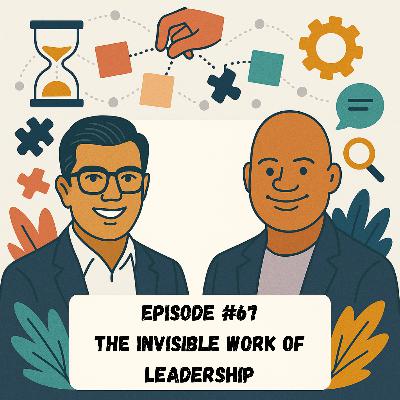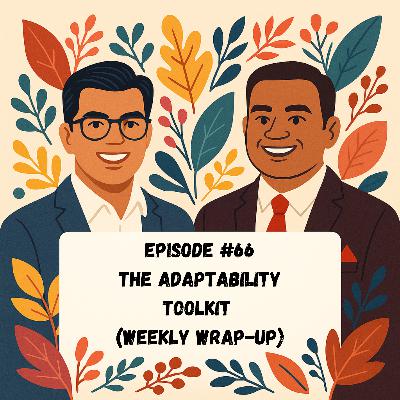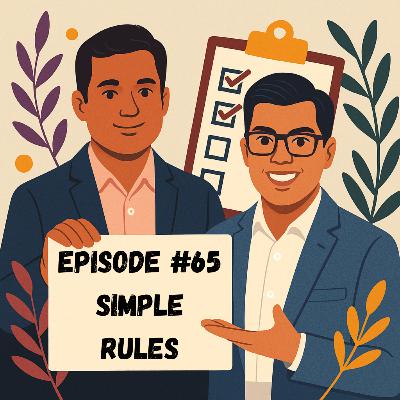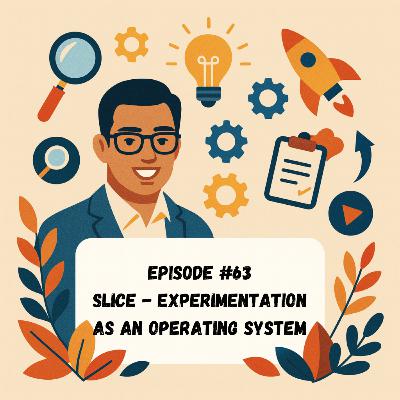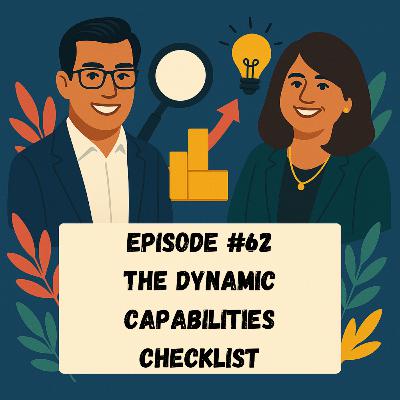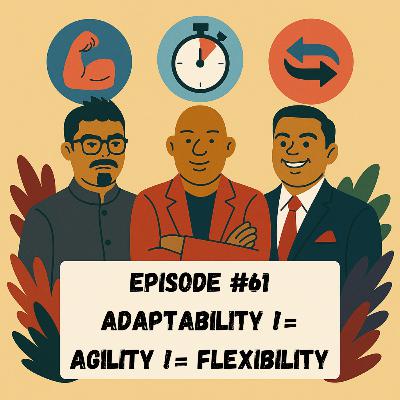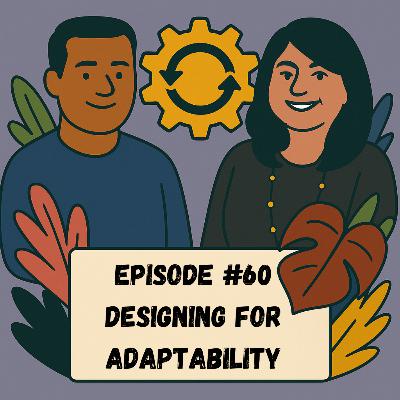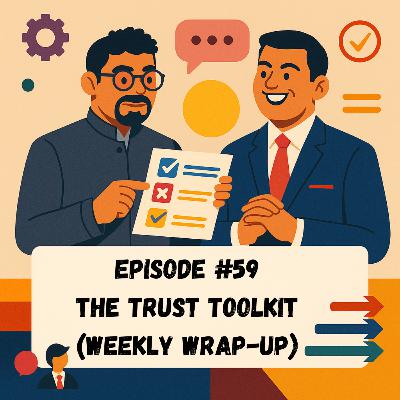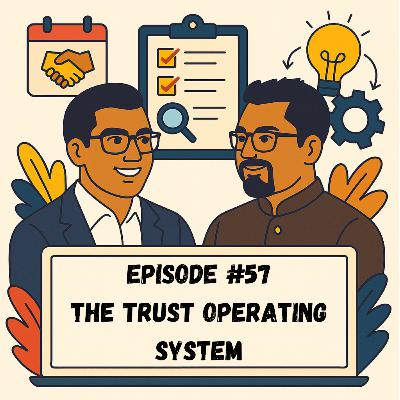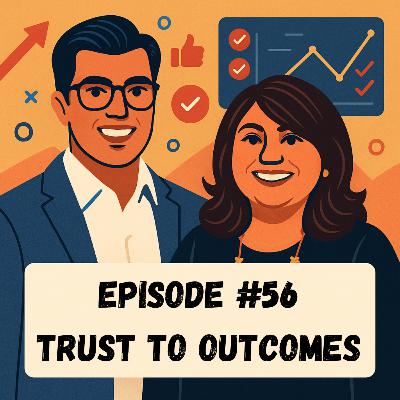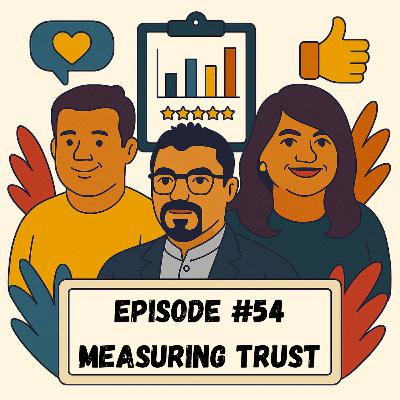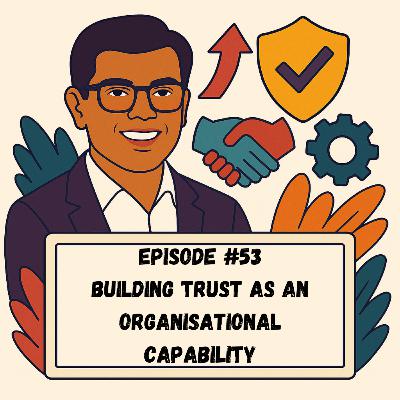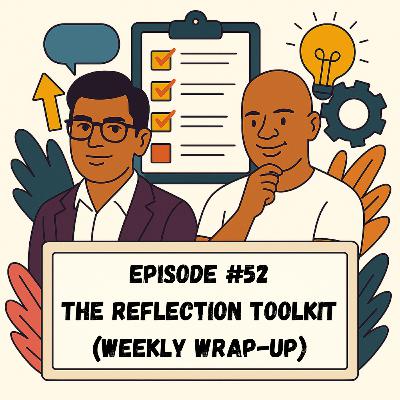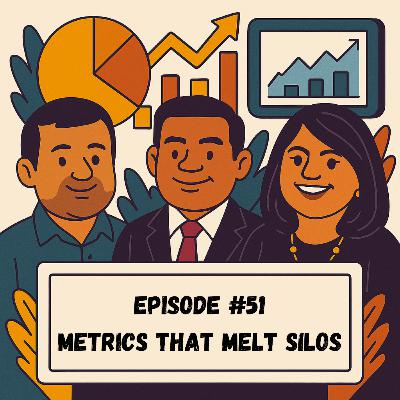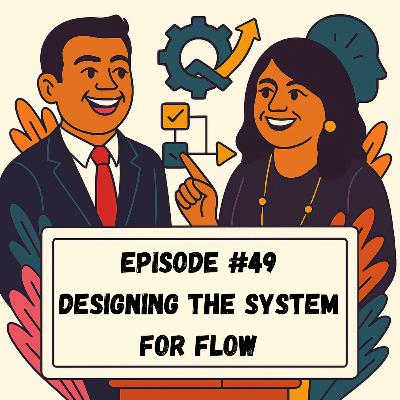Discover The EnterpriseJoy Podcast
The EnterpriseJoy Podcast

The EnterpriseJoy Podcast
Author: EnterpriseJoy
Subscribed: 2Played: 0Subscribe
Share
© 396767
Description
Hosted by Vishal Prasad, this is your daily dose of strategic clarity across HOPE - Humans, Operations, Products, and Engineering; delivered to you by the time your barista gets your coffee.
One theme per week. Seven crisp episodes. And actionable strategic insights backed by research.
No videos. No reels. Just pure podcast made for your walks, commute, breaks, or wind-down. Designed for CXOs, founders, and bold leaders who prefer momentum over meditation.
TL;DR: Enterprise Strategies for Leaders in Under 5 Minutes, because good things shouldn’t take time. That’s The EnterpriseJoy Podcast.
One theme per week. Seven crisp episodes. And actionable strategic insights backed by research.
No videos. No reels. Just pure podcast made for your walks, commute, breaks, or wind-down. Designed for CXOs, founders, and bold leaders who prefer momentum over meditation.
TL;DR: Enterprise Strategies for Leaders in Under 5 Minutes, because good things shouldn’t take time. That’s The EnterpriseJoy Podcast.
68 Episodes
Reverse
In this episode, we pull back the curtain on the six categories of invisible work and show you how to spot them in your own calendar. You’ll learn why these unseen activities matter, how uneven loads create burnout risks, and a simple four-step scan to surface where your energy is really going.References:1) Sensemaking in Organizations: https://www.goodreads.com/book/show/818257.Sensemaking_in_Organizations2) Will AI Fix Work? Work Trend Index: https://www.microsoft.com/en-us/worklab/work-trend-index/will-ai-fix-work3) Are You Taking on Too Many Non-Promotable Tasks? https://hbr.org/2022/04/are-you-taking-on-too-many-non-promotable-tasks4) Being Glue: https://www.noidea.dog/glue5) Noise: A Flaw in Human Judgment: https://www.goodreads.com/book/show/55339408-noise6) Creativity, Inc.: Overcoming the Unseen Forces That Stand in the Way of True Inspiration: https://www.goodreads.com/book/show/63934894-creativity-inc-the-expanded-editionMusic Credit: Switch It Up, performed by Silent Partner, from the YouTube Studio Audio Library.
In this episode, we dive into the hidden side of leadership, the work that never makes it to dashboards or OKRs but holds organisations together. From Karl Weick’s sensemaking to Linda Babcock’s research on non-promotable tasks, from Tanya Reilly’s “Being Glue” in engineering teams to Paul O’Neill’s safety-first turnaround at Alcoa, we explore how invisible work shapes trust, efficiency, and performance. References:1) Sensemaking in Organizations: https://www.goodreads.com/book/show/818257.Sensemaking_in_Organizations2) Will AI Fix Work? Work Trend Index: https://www.microsoft.com/en-us/worklab/work-trend-index/will-ai-fix-work3) Are You Taking on Too Many Non-Promotable Tasks? https://hbr.org/2022/04/are-you-taking-on-too-many-non-promotable-tasks4) Being Glue: https://www.noidea.dog/glue5) Alcoa’s Core Values in Practice: Paul O’Neill’s Safety Focus: https://www.hbs.edu/faculty/Pages/item.aspx?num=26838Music Credit: Switch It Up, performed by Silent Partner, from the YouTube Studio Audio Library.
In this weekly wrap-up episode, we stitch adaptability into a practical toolkit. From Monday’s distinction between flexibility, agility, and adaptability, to Tuesday’s litmus test, to Wednesday’s SLICE experimentation engine, Thursday’s levers of decision velocity and resource mobility, and Friday’s simple rules. You’ll walk away with a one-page adaptability playbook that helps you sense shifts, run disciplined experiments, move faster, free up resources, and guide decisions with clarity.References:1) Dynamic capabilities and strategic management: https://doi.org/10.1002/(SICI)1097-0266(199708)18:7<509::AID-SMJ882>3.0.CO;2-Z2) Dynamic capabilities as (workable) management systems theory: https://doi.org/10.1017/jmo.2017.753) Trustworthy online controlled experiments: A practical guide to A/B testing: https://www.cambridge.org/core/books/trustworthy-online-controlled-experiments/4) Simple Rules: How to thrive in a complex world: https://www.hmhbooks.com/shop/books/Simple-Rules/97805447052035) Heuristic decision making: https://doi.org/10.1146/annurev-psych-120709-145346Music Credit: Switch It Up, performed by Silent Partner, from the YouTube Studio Audio Library
In this episode, Vishal unpacks why simple rules are a leader’s best weapon in complex systems. Backed by research, this episode shows how three to five crisp heuristics can outperform thick manuals and guide decisions without bottlenecks. From wildfire management’s legendary LCES rule set to corporate playbooks that focus on boundaries, priorities, and timing, you’ll learn how to design rules that travel fast, scale under stress, and stick in people’s heads when leaders aren’t in the room.References:1) Simple Rules for a Complex World. Harvard Business Review: https://hbr.org/2012/09/simple-rules-for-a-complex-world2) The best rules are simple, flexible and purposeful: https://news.stanford.edu/stories/2015/04/rules-simple-eisenhardt-0429153) LCES — Lookouts, Communications, Escape Routes, Safety Zones: https://fs-prod-nwcg.s3.us-gov-west-1.amazonaws.com/s3fs-public/2023-06/lces-gleason.pdf4) Fast and frugal forecasting: https://doi.org/10.1016/j.ijforecast.2009.05.0105) Ecological Rationality: Fast-and-Frugal Heuristics for Managerial Decision Making under Uncertainty: https://doi.org/10.5465/amj.2018.0172Music Credit: Switch It Up, performed by Silent Partner, from the YouTube Studio Audio Library
In this episode, Vishal explores why adaptability fails without Decision Velocity and Resource Mobility. Backed by research and examples from Jeff Bezos and Piyush Gupta, this episode urges leaders to halve their “signal-to-decision” time and free up capital and talent for new bets. You’ll walk away with practical litmus tests and a simple one-pager to publish in your teams.References:1) DBS: Digital Transformation to Best Bank in the World: https://store.hbr.org/product/dbs-digital-transformation-to-best-bank-in-the-world/SMU816?srsltid=AfmBOopcxwtvJKsOiz8sJsmVjP3KS7DQFY6Tabz0tYRaQJE0ujCwp8Kz2) Decision-making in the age of urgency: https://www.mckinsey.com/capabilities/people-and-organizational-performance/our-insights/decision-making-in-the-age-of-urgency3) How to make the bold strategy moves that matter: https://www.mckinsey.com/capabilities/strategy-and-corporate-finance/our-insights/how-to-make-the-bold-strategy-moves-that-matterMusic Credit: Switch It Up, performed by Silent Partner, from the YouTube Studio Audio Library
In this episode, Vishal introduces SLICE (Select, Learn, Implement, Chronicle, Expand) as a practical operating system for experimentation. This episode explores how adaptability comes from a repeatable rhythm of trustworthy experiments. You’ll hear how SLICE helps leaders build experimentation into their organisation’s DNA and makes innovation a habit.References:1) SLICE - Experimentation as an Operating System: https://medium.com/@vishalprasadin/slice-b1f1e7aa2aa42) Building a Culture of Experimentation: https://hbr.org/2020/03/building-a-culture-of-experimentation3) The Discipline of Business Experimentation: https://hbr.org/2014/12/the-discipline-of-business-experimentation4) Trustworthy Online Controlled Experiments: A Practical Guide to A/B Testing: https://www.goodreads.com/book/show/51635906-trustworthy-online-controlled-experiments5) Learning from Jeff Bezos: Big winners pay for so many experiments: https://versionone.vc/learning-jeff-bezos-big-winners-pay-many-experiments/Music Credit: Switch It Up, performed by Silent Partner, from the YouTube Studio Audio Library
In this episode, Vishal unpacks adaptability through the lens of dynamic capabilities; sensing, seizing, and transforming. Drawing from strategy research and the real-world case of DBS Bank’s digital transformation, this episode breaks theory into a practical checklist: how to spot early signals before they erupt, convert them into committed bets, and rewire the organisation to sustain change. If you can answer the three checklist questions without hesitation, you’re running adaptability by design; if not, this is where you start.References:1) Explicating dynamic capabilities: the nature and microfoundations of (sustainable) enterprise performance: https://doi.org/10.1002/smj.6402) Dynamic Capabilities: What Are They? https://sms.onlinelibrary.wiley.com/doi/abs/10.1002/1097-0266%28200010/11%2921%3A10/11%3C1105%3A%3AAID-SMJ133%3E3.0.CO%3B2-E3) DBS: Digital Transformation to Best Bank in the World: https://ink.library.smu.edu.sg/cases_coll_all/309/4) Adaptability: The New Competitive Advantage: https://hbr.org/2011/07/adaptability-the-new-competitive-advantage5) McKinsey & Company (2016). How Nimble Resource Allocation Can Double Your Company’s Value: https://www.mckinsey.com/capabilities/strategy-and-corporate-finance/our-insights/how-nimble-resource-allocation-can-double-your-companys-valueMusic Credit: Switch It Up, performed by Silent Partner, from the YouTube Studio Audio Library
In Episode of The EnterpriseJoy Podcast, Vishal untangles three terms leaders often confuse; adaptability, agility, and flexibility. Drawing on research and real-world cases, he explains why flexibility is about range, agility is about pace, and adaptability is about evolution. You’ll hear how Netflix’s pivot to streaming wasn’t just agility in action, but true adaptability; a deliberate reconfiguration of its business model and culture. The episode leaves you with a practical challenge so you can stop solving the wrong problem and start leading with clarity.References:1) What Really Makes Factories Flexible? https://hbr.org/1995/07/what-really-makes-factories-flexible2) Explicating dynamic capabilities: the nature and microfoundations of (sustainable) enterprise performance: https://doi.org/10.1002/smj.6403) How Netflix Reinvented HR: https://hbr.org/2014/01/how-netflix-reinvented-hr4) Adaptability: The New Competitive Advantage: https://hbr.org/2011/07/adaptability-the-new-competitive-advantageMusic Credit: Switch It Up, performed by Silent Partner, from the YouTube Studio Audio Library
In this Sunday setup of The EnterpriseJoy Podcast, we dive into Designing for Adaptability. Vishal unpacks why adaptability is no longer a leadership buzzword but a survival toolkit, backed by decades of research showing volatility has doubled since the 1980s. You’ll hear how strategy scholars define “dynamic capabilities” and why leaders like Adobe’s Shantanu Narayen bet big on adaptability to reshape industries. Expect a week ahead filled with practical routines: from distinguishing adaptability from agility, to running experimentation as an operating system, to boosting decision velocity and crafting simple rules that travel.References:1) Explicating dynamic capabilities: the nature and microfoundations of (sustainable) enterprise performance: https://doi.org/10.1002/smj.6402) Dynamic Capabilities: What Are They? https://sms.onlinelibrary.wiley.com/doi/abs/10.1002/1097-0266%28200010/11%2921%3A10/11%3C1105%3A%3AAID-SMJ133%3E3.0.CO%3B2-E3) Adobe’s CEO on Making Big Bets on Innovation: https://hbr.org/2023/11/adobes-ceo-on-making-big-bets-on-innovationMusic Credit: Switch It Up, performed by Silent Partner, from the YouTube Studio Audio Library
In this wrap-up episode, we bring the week on trust to a close by consolidating everything measurement, behaviours, outcomes, and routines into a one-page Trust Toolkit you can carry into your Monday leadership meeting. Vishal explains how to blend metrics like the ABI model, behavioural and organisational trust inventories, and psychological safety with simple weekly habits and routines like decision logs, blameless post-mortems, and working agreements. The result? A lightweight, repeatable system that builds trust not through intensity, but through consistency.Music Credit: Switch It Up, performed by Silent Partner, from the YouTube Studio Audio Library
In this episode, we step outside the walls of the organisation and explore how external trust becomes a growth lever for AI. Using the three lenses of Assure, Explain, and Control, Vishal unpacks how frameworks from ISO and the EU AI Act are shaping the market’s expectations of risk, transparency, and governance. You’ll hear why assurances turn “trust us” into “audit us,” why transparency notes and data provenance lower adoption friction, and why serious-incident pathways build resilience before a crisis. And most importantly, how small visible artefacts move real outcomes from shorter sales cycles to higher adoption.References:1) AI Risk Management Framework (AI RMF 1.0): https://www.nist.gov/itl/ai-risk-management-framework2) ISO/IEC 23894:2023 Information technology — Artificial intelligence — Guidance on risk management: https://www.iso.org/standard/77304.html3) ISO/IEC 42001:2023 — Information technology — Artificial intelligence — Management system: https://www.iso.org/standard/81230.html4) EU Artificial Intelligence Act: https://artificialintelligenceact.eu/the-actMusic Credit: Switch It Up, performed by Silent Partner, from the YouTube Studio Audio Library
In this episode, we move from talking about trust as a value to embedding it as a system. Vishal unpacks how decision logs, blameless post-mortems, and working agreements transform trust into repeatable routines that reduces friction, increases predictability, and accelerates learning. You’ll hear why transparent artefacts signal fairness, how debriefs improve team effectiveness, and why simple, team-owned agreements outperform top-down rules. Together, these practices create a “Trust Operating System”, your shock absorbers under pressure and your reliability amplifier in the long run.References:1) Reconceptualizing organizational routines as a source of flexibility and change: https://doi.org/10.2307/35566202) Do team and individual debriefs enhance performance? A meta-analysis: https://doi.org/10.1177/00187208124483943) Failing to learn and learning to fail (intelligently): How great organizations put failure to work to innovate and improve: https://doi.org/10.1016/j.lrp.2005.04.005 4) Laying the foundation for successful team performance trajectories: The roles of team charters and performance strategies: https://doi.org/10.1037/a0013257Music Credit: Switch It Up, performed by Silent Partner, from the YouTube Studio Audio Library
In this episode, we connect trust directly to business results you can measure. Research shows that higher trust reduces turnover, strengthens engagement, and sharpens performance. You’ll hear why trust acts as an early-warning system for attrition, how fair process and transparency fuel employee commitment and innovation, and why teams with strong psychological safety outperform under pressure. We’ll also explore practical lenses for leaders, from spotting red flags in disclosure and meeting dynamics to linking trust scores with cycle time, retention, and quality on a simple Trust → Outcomes dashboard ensuring that trust becomes an operational capability.References1) Trust in leadership: Meta-analytic findings and implications for research and practice: https://doi.org/10.1037/0021-9010.87.4.6112) Trust and team performance: A meta-analysis of main effects, moderators, and covariates: https://doi.org/10.1037/apl00001103) Psychological safety: A meta-analytic review and extension: https://doi.org/10.1111/peps.121834) Authentic leadership: Development and validation of a theory-based measure: https://doi.org/10.1177/0149206307308913Music Credit: Switch It Up, performed by Silent Partner, from the YouTube Studio Audio Library
In this episode, we move from measuring trust to living it through behaviours leaders practise daily. Drawing on Frances Frei’s “Trust Triangle,” we explore how authenticity, logic, and empathy form the three legs of trust, and why a wobble in any one weakens the whole. This episode includes practical micro-habits to apply this week: framing decisions with principles and constraints, narrating reasoning with clarity and uncertainty, and running inclusion rounds that make every voice count. By Friday, you’ll know exactly which habits create the strongest ripple for your team.References:1) Unleashed: The Unapologetic Leader’s Guide to Empowering Everyone Around You: https://www.goodreads.com/book/show/49208248-unleashed2) Authentic leadership: Development and validation of a theory-based measure: https://doi.org/10.1177/01492063073089133) Justice at the millennium: A meta-analytic review of 25 years of organizational justice research: https://doi.org/10.1037/0021-9010.86.3.4254) Making it safe: The effects of leader inclusiveness and professional status on psychological safety and improvement efforts in health care teams: https://doi.org/10.1002/job.4135) Trust in leadership: Meta-analytic findings and implications for research and practice: https://doi.org/10.1037/0021-9010.87.4.611Music Credit: Switch It Up, performed by Silent Partner, from the YouTube Studio Audio Library
In this episode, we take trust out of the “soft skill” bucket and put it into the measurable category where it belongs. You’ll hear how the ABI model (ability, benevolence, integrity) providing a reliable lens to assess trustworthiness, and why inventories like the Organisational Trust Inventory, the Behavioural Trust Inventory, and McAllister’s cognition- and affect-based scale give you practical tools to take a baseline pulse. We also connect trust to psychological safety as the everyday signal of whether people feel safe to speak up. Expect a lightweight framework you can apply immediately: a short pulse survey, spotting asymmetries, and committing to one visible action.References:1) An Integrative Model of Organizational Trust: https://doi.org/10.5465/amr.1995.95080803352) The Organizational Trust Inventory (OTI): Development and Validation: https://doi.org/10.4135/9781452243610.n153) Measuring trust in working relationships: The Behavioural Trust Inventory: https://webarchive.nla.gov.au/awa/20040916012254/http://pandora.nla.gov.au/pan/37069/20031216-0000/www.mbs.unimelb.edu.au/downloads/wp/WP_2003_14.pdf4) Affect- and cognition-based trust as foundations for interpersonal cooperation in organizations: https://www.jstor.org/stable/256727Music Credit: Switch It Up, performed by Silent Partner, from the YouTube Studio Audio Library
In this opening episode of the week, we reframe trust as an economic driver and a measurable capability. Backed by Stephen M. R. Covey’s insights and decades of organisational research, we explore why high-trust teams consistently outperform, how the ABI model (ability, benevolence, integrity) explains trust dynamics, and why psychological safety is the everyday expression of it. This week, expect a practical roadmap to measure, design, and scale trust; turning it into your organisation’s most overlooked yet powerful performance asset.References:1) The Speed of Trust: The One Thing That Changes Everything: https://www.goodreads.com/book/show/36076.The_Speed_of_Trust2) Trust and team performance: A meta-analysis of main effects, moderators, and covariates: https://doi.org/10.1037/apl00001103) Trust in leadership: Meta-analytic findings and implications for research and practice: https://doi.org/10.1037/0021-9010.87.4.6114) An Integrative Model of Organizational Trust: https://doi.org/10.5465/amr.1995.95080803355) AI at a Crossroads: Building Trust as the Path to Scale.https://www.deloitte.com/au/en/Industries/consumer/analysis/trustworthy-artificial-intelligence.htmlMusic Credit: Switch It Up, performed by Silent Partner, from the YouTube Studio Audio Library
In this wrap-up episode of The EnterpriseJoy Podcast, Vishal brings the week together with a Reflection Toolkit, a one-page-one-hour practice your team can start right away. Using Alan Mulally’s turnaround at Ford as proof, the toolkit blends service blueprinting, value stream mapping, shared outcome scorecards, Team APIs, psychological safety cues, and boundary-spanning rituals. Simply put, when teams reflect regularly, silos stop being walls and start becoming bridges.References:1) Psychological safety and learning behavior in work teams: https://doi.org/10.2307/26669992) Project Aristotle: Understanding team effectiveness: https://rework.withgoogle.com/intl/en/guides/understanding-team-effectiveness3) Do team and individual debriefs enhance performance? A meta-analysis: https://doi.org/10.1177/00187208124483944) Learning to See: Value Stream Mapping to Add Value and Eliminate MUDA: https://www.goodreads.com/book/show/20323099-learning-to-see5) A Proof for the Queuing Formula: L = λW: https://pubsonline.informs.org/doi/10.1287/opre.9.3.3836) The Balanced Scorecard — Measures that Drive Performance: https://hbr.org/2005/07/the-balanced-scorecard-measures-that-drive-performance7) Smarter Collaboration: A New Approach to Breaking Down Barriers and Transforming Work: https://www.goodreads.com/book/show/60623881-smarter-collaboration8) Team Topologies: Organizing Business and Technology Teams for Fast Flow: https://www.goodreads.com/book/show/44135420-team-topologies9) Ford lost record $12.7 billion in 2006: https://www.nytimes.com/2007/01/25/business/worldbusiness/25iht-web.0125ford.4339480.html10) You can’t manage a secret: https://www.governing.com/archive/col-culture-openness-candor-critical-organizational-success.htmlMusic Credit: Switch It Up, performed by Silent Partner, from the YouTube Studio Audio Library
When silos each chase their own scoreboard, organisations slow down. In this episode, Vishal explores how just five well-chosen measures can align entire enterprises around outcomes that matter. These “Friday Five” metrics shift the conversation from “my team delivered” to “our system must improve,” melting silos into collective accountability.References:1) The Balanced Scorecard — Measures that Drive Performance: https://hbr.org/2005/07/the-balanced-scorecard-measures-that-drive-performance2) Accelerate: Building and Scaling High Performing Technology Organizations: https://www.goodreads.com/book/show/35747076-accelerate3) A Proof for the Queuing Formula: L = λW. Operations Research, 9(3), 383–387.https://pubsonline.informs.org/doi/10.1287/opre.9.3.3834) Putting the Service-Profit Chain to Work: https://hbr.org/2008/07/putting-the-service-profit-chain-to-work5) Stop Trying to Delight Your Customers: https://hbr.org/2010/07/stop-trying-to-delight-your-customers6) Project to Product: How to Survive and Thrive in the Age of Digital Disruption with the Flow Framework: https://www.goodreads.com/book/show/40679042-project-to-productMusic Credit: Switch It Up, performed by Silent Partner, from the YouTube Studio Audio Library
In this milestone 50th episode, Vishal unpacks why even the best-designed pods and scorecards collapse without psychological safety. Drawing on research from Amy Edmondson, Google’s Project Aristotle, and the Center for Creative Leadership, he explains how trust enables teams to span boundaries and solve problems at scale. Expect practical rituals like weekly dependency huddles, immediate retrospectives, and end-to-end demo days turning cross-team collaboration from stressful heroics into sustainable a rhythm.References:1) Psychological Safety and Learning Behavior in Work Teams: https://doi.org/10.2307/26669992) Project Aristotle: Understanding team effectiveness:vhttps://rework.withgoogle.com/intl/en/guides/understanding-team-effectiveness3) Bridging the Boundary: External Activity and Performance in Organizational Teams: https://doi.org/10.2307/23934754) Boundary Spanning Leadership: Mission Critical Perspectives from the Executive Suite: https://cclinnovation.org/wp-content/uploads/2020/02/boundaryspanningleadership.pdf5) Do Team and Individual Debriefs Enhance Performance? A Meta-Analysis: https://doi.org/10.1177/0018720812448394Music Credit: Switch It Up, performed by Silent Partner, from the YouTube Studio Audio Library
In this episode, Vishal explores how to design organisations that deliver flow rather than friction. From Conway’s Law to value-stream pods, Team APIs, and evidence-backed metrics like DORA and the Flow Framework, you’ll discover how structure and communication shape the very product you build. References:1) How Do Committees Invent? https://www.melconway.com/Home/Conways_Law.html2) The Product Operating Model: https://www.svpg.com/the-product-operating-model-an-introduction3) Team Topologies: Organizing Business and Technology Teams for Fast Flow: https://www.goodreads.com/book/show/44135420-team-topologies4) Accelerate: Building and Scaling High Performing Technology Organizations: https://www.goodreads.com/book/show/35747076-accelerate5) Project to Product: How to Survive and Thrive in the Age of Digital Disruption with the Flow Framework: https://www.goodreads.com/book/show/40679042-project-to-product6) Team API Template: https://github.com/TeamTopologies/Team-API-templateMusic Credit: Switch It Up, performed by Silent Partner, from the YouTube Studio Audio Library



